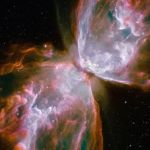Cosmic butterfly reveals crystals, fiery jets and life-linked molecules in Webb image

Source: interestingengineering
Author: Aamir Khollam
Published: 8/27/2025
To read the full content, please visit the original article.
Read original articleAstronomers using the James Webb Space Telescope (JWST) have made significant discoveries in the Butterfly Nebula (NGC 6302), located 3,400 light-years away, shedding light on how rocky planets like Earth may form. Webb’s infrared instruments revealed a dense torus of dust surrounding an extremely hot central star (220,000 Kelvin), containing crystalline silicates such as quartz alongside larger-than-usual dust grains. These findings suggest that cosmic dust, the building blocks of planets, can form and grow under both calm and violent cosmic conditions, providing new insights into dust formation processes in space.
The observations also detected carbon-based molecules known as polycyclic aromatic hydrocarbons (PAHs), which are linked to life-friendly chemistry and are commonly found on Earth in smoke and exhaust. This may be the first evidence of PAHs forming inside an oxygen-rich planetary nebula, indicating complex organic chemistry occurring in such environments. Additionally, iron and nickel were traced in powerful jets emanating from the
Tags
materialscosmic-dustcrystalline-silicatespolycyclic-aromatic-hydrocarbonsplanetary-nebulaJames-Webb-Space-Telescopespace-chemistry